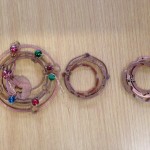Debbie Watson, Simon Poulter, Sophie Mellor and Marilyn Howard reflect on their ‘Life Chances’ : the project co-development of a fictional novel with community participants.
Eleven people sit around a table, there is a smell of brasso and enamel paint and a gentle buzz of people polishing, clinking metal fixings, turning wire, asking each other for pliers, paint brushes and sharing the beads available. Aya is telling us about how the design for her jewellery is based on a celebratory necklace in her country. Sophie gently interjects: ‘so can we talk a little about the character Seynab? She is making her way across Europe with her young daughter… where is she now? Heba replies: ‘I think she has managed to get a lift on a truck with some people who speak her language. Her little girl keeps crying and holding on to her….’ Simon asks: ‘So how is she feeling?’ Naomi replies: ‘She is scared and not sure she should trust these people. Someone has offered her some bread and she took it as she hoped it would stop her daughter crying as some of the men on the truck look cross’.
Co-developing a fictional novel with community participants has led us to question the role of fiction in sociological research in new ways and to challenge what we are attempting to produce. We think we are using this method of devising to reach into peoples’ ‘minority knowledge’. If the Government is using the rhetoric of ‘life chances’ to propagandise a method of governance, this implies that each person’s life knowledge gives them insights and understandings. And this has value. In improvising with the group we realised that we could use this as a symbolic language of power – directing aspects of the fiction.
There are different types of fiction e.g. ‘fictional ethnography’ or ‘creative non-fiction’ and debates about the extent to which fiction in research is ever a fiction, or more akin to speculative realism and the ‘theory-fiction’ of Nick Land (among others). But our experience has made us question whether the presumed binary of fiction and non-fiction is helpful and indeed whether blurring these helps in defining our goals. The Life Chances novel is using fictional characters based on non-fictional experiences, but could this be criticised for being ‘too fictional’ (e.g. exaggerated) or too ‘non-fictional’ (e.g. picking out storylines on some issues out of context?). If research participants fictionalise only what they know (e.g. characters like themselves) this could be one-dimensional as the (macro) knowledge and tools to fictionalise a character from outside/from a regulatory system are limited. An interesting discussion in one group focused on what happens when an asylum seeker arrives in the country – where do they need to register their asylum claim? Some participants were adamant that ‘Seynab’ would need to travel to Liverpool to register for asylum, whilst others were equally convinced that this could be done in any city; or that Liverpool is only for those lodging an appeal. Participants were invited to ‘research’ this and bring it back to the group so we were presenting factual information – yet a review of the Home Office website on ‘Immigration Rules’, whilst extensive in respect of legal aspects of compliance, which forms need to be completed and what evidence the applicant requires in order to be considered, does not explain where that person might need to go. So, what is the place of ‘fact’ in the co-produced characterisations and plot lines of the fiction? 
Life Chances, as an arts-based research project is for us a method of postponing conventions on how things are done and trying things out. Most people would imagine that doing co-research, authoring and art production at the same time is difficult and handing co-authoring over to a group is problematic because of underlying expectations of ability or time. So, in effect we are entering into an indeterminate creative space where everyone contributes to an outcome, in this case a fiction. The process of indeterminacy (deliberate oxymoron) facilitates a wide array of responses and contributions. It jumps, stalls and creates debate or can be didactic. But importantly it seems ethically correct that engagement in a research process should result in participants receiving quality understandings of regulatory systems (universal credit for example) because misunderstandings and disinformation exist in the mainstream and this leads to further inequality. An outcome from an arts-based research project can be a description of universal credit, how bizarre……
We also want the novel to enable participants to describe different futures – re-imagining what the welfare state might be like if children and families were at the centre of decisions rather than bureaucratic categories. ‘Utopias’ (as in More’s, 1516 Utopia) has been a vehicle for this. Utopias can provide a fictionalised account of living in a different regime/highlighting different social and political values – though often reflect the values of the time. People have multi-layered stories and fictionalisation helps to access these to find material for alternative futures. Through co-writing we ask participants to abstract from themselves and to embody alternative characters, giving freedom to be something different, although limited by individual horizons of experience. Yet the horizons can co-exist in a fictional space that is not regulated. How does ‘Michael’, for example, gain his training as a teacher so he can go back to his country of birth and contribute to improving the education for children there?
Fictionalisation does, we believe carry risks (emotional, social, academic, political) but also opportunities to find interstices and spaces within which to re-examine and see sociological issues from new vantage points. That reflexive re-positioning of selves demands courage and skill and an empathetic and supportive environment. Following from Philip K Dick and others, it is important to note that fiction projects onto and into reality. In many ways our utopian focus has parallels with Dick’s science fiction works, as common to his approach were alternative worlds and simulacra as plot devices, with fictional worlds inhabited by common, working people. Sociology is empirical, scientific and analytical in mode, so if in this sense it is ‘science’ then we can usefully problematise the method with improvisation and find interesting borders through art and creativity. We can use fiction or placing people in a ‘confidential’ location (metaphorically and physically) to elicit responses that might not otherwise be forthcoming. Shifting people from ‘everyday’ patterns to creative patterns of working can illuminate and empower them to see how they can claim more creative time and approaches for themselves.
What then is the difference between writing sociological fiction and being sociologists who write fiction? We are influencing our own assumptions of what is going on and can therefore not be disconnected as non-interested observers of social space. Joseph Beuys is an interesting artist in this respect because he joins up thinking between sociology and art practice. In defining ‘social sculpture’ Beuys proposes that art can influence our responses to life and the environment, and he adopted and embodied a shamanist role through both his art and life. To him, the shaman allowed rationality and emotion to be combined, and such integration is made possible for us in fictional co-writing. ‘Seynab’s’ story could be told through sociological writing -good life history or hermeneutic interviewing could reveal more of her emotional state as she travels across Europe and applies for asylum. But fictionalisation permits us to ask these questions overtly and to explore alternative, multi-layered accounts, her fears and aspirations and the emotions she carries whilst attempting to keep herself and her young daughter safe. As a member of a jewellery-making co-operative ‘Seynab’ meets other characters, her story is shared and different utopias imagined. What does ‘Michael’ with his aspiration of returning to his country of birth, think about her telling of recent experiences there? Does it change his future?
This Blog first appeared on The Sociological Review blog section on the 20 March, 2016









